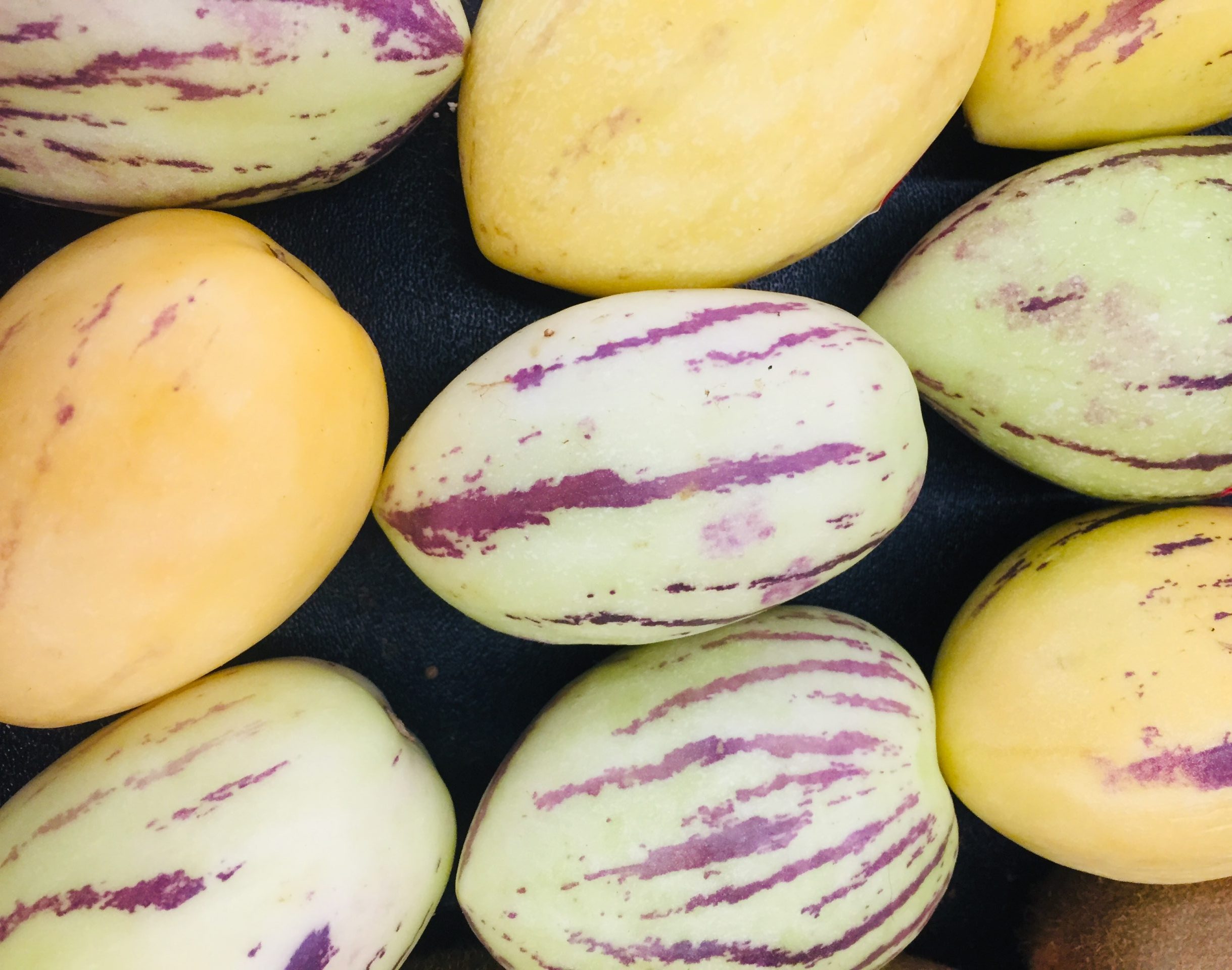Pepino melon – The perennial pepino shrub often produces an abundance of fruit in various types of conditions. It has recently become more popular to plant in home gardens, especially in warmer climates. Where it originates naturally is South America, where the climate is warmer and humid.
If you’re wondering what it is, where to grow pepino plants, and when to harvest pepino melon, read on to learn more about these unique fruits. The great news is you can grow them outdoors or indoors.
What Is a Pepino Melon?
A pepino melon, also known as pepino dulce, sweet cucumber, pepino cucumber, melon pear, and pear melon. It’s a fruit that is usually about the size of an adult palm or a size of small-to-medium-sized avocado. They can be round, oval, or pear-shaped.
Pepinos have smooth and glossy greenish or yellow skin and purple stripes when it is ripe. The fruit usually gives off a sweet aroma when it is ripe, similar to a cantaloupe.
The outer skin is thin, making it easy to cut through. Inside, there is a cluster of seeds, which are edible, and the fruit itself is pale orange. Its scientific name is Solanum muricatum. They are in the nightshade family.
What Does Pepino Melon Taste Like?
A pepino melon tastes like a combination of a cantaloupe or honeydew melon with a cucumber. It has a mildly sweet taste with the watery and soft texture of a cucumber. The taste and flavor may not appeal to everyone, but it makes a refreshing snack.
If you wonder how to eat pepino melon, there are several ways.
- You can eat a pepino by itself like an apple, or drizzled with sugar or honey to make it less acidic. The entire fruit, including the seeds, are edible, though the skin may be tougher if the fruit is ripe.
- You can slice this fruit like a melon and just eat the inside, dice it and add it to salads, or cook it like squash.
- If it’s not yet ripe, you can cook pepino melon like you would squash.
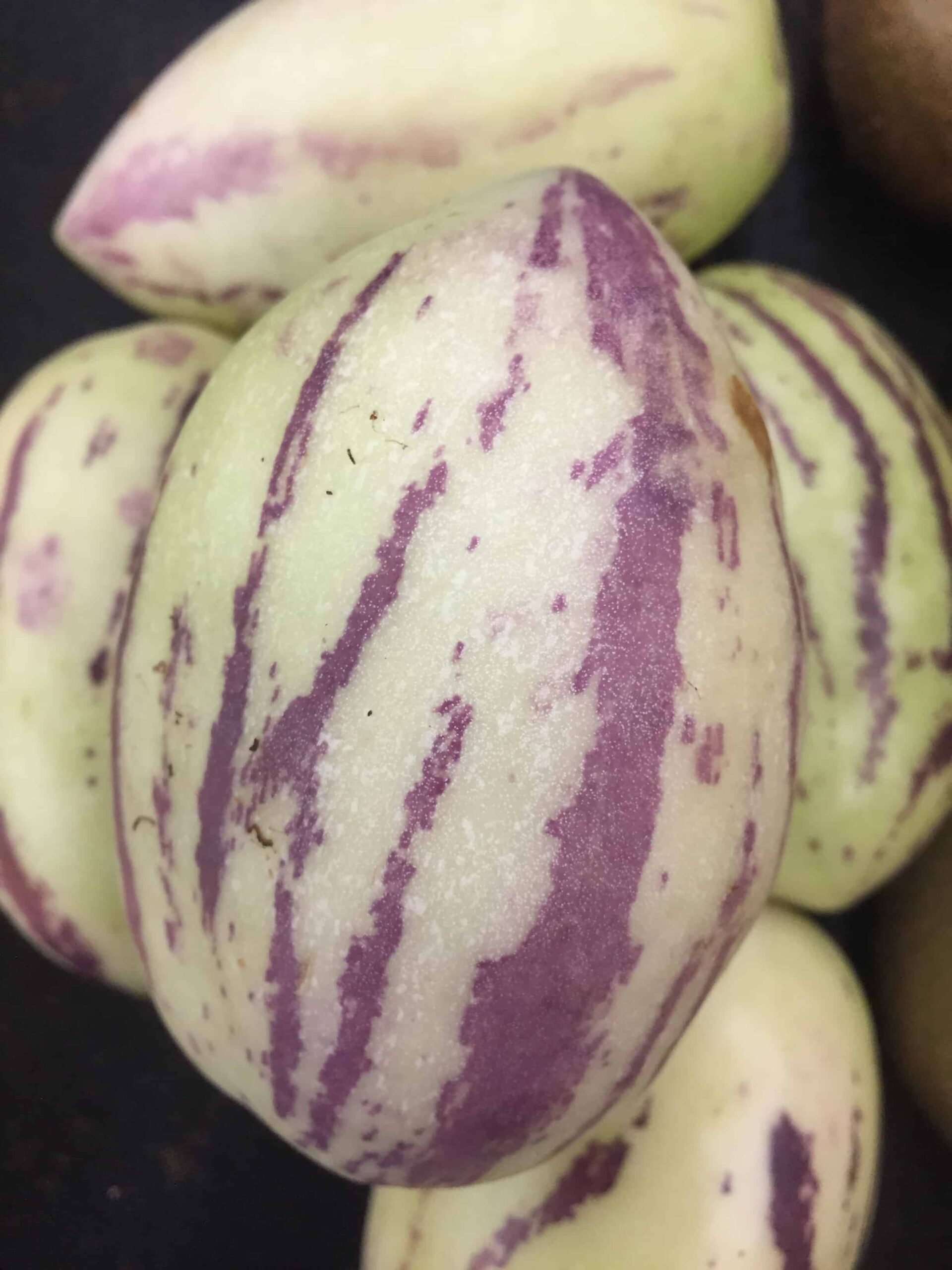
Growing Pepino Plants
If you are looking to grow a pepino plant in your home garden or a pot, here are some tips on what it needs to grow and how to harvest the ripened fruit. It’s a low-maintenancee plant and is easy to grow in warm climates.
Requirements
- Right climate
- Sunlight
- Soil
Pepino bushes grow best in a temperate climate. To thrive outdoors, their hardiness zone is 8 – 11. They require good exposure to sunlight withaa minimum of six hours per day to bear fruit.
Like other fruits, they require a slightly alkaline or neutral pH soil levelof around 6.5 – 7.5. Water daily until it’s established.Afterwards, water twice weekly in hot weather; once weekly other times.
Successful pepino melon farming requires healthy soil. Amending organic mulch, like sugar cane, will help the bush produce larger and sweeter fruit.
However, the pepino plant is quite resilient and can grow in various soil types, like sandy or loamy dirt or clay. You can prune them to keep them smaller but it’s not necessary. Remove broken branches. Though pepino melons do well planted directly into the ground, you can grow them well in pots.
There are several reasons to grow them in pots. They are ideal for patios and small garden spaces. Also, if you live in a colder climate, you can move the potted plant indoors or to a sheltered spot when freezing temperatures threaten.
How to Grow Pepino Melon
Depending on where you live, you may prefer to grow a pepino plant in the ground or a pot you can sit on your terrace or balcony. Here are some ways to grow the pepino melon in both places.
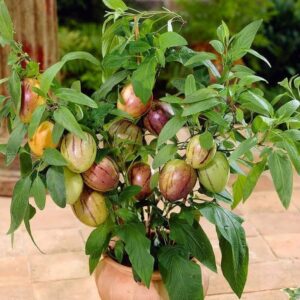
Growing Pepinos in the Ground
Pepino bushes grow up to 3 feet wide (1 meter) and 3 feet tall. Like tomato plants, you can cage them or grow them on a trellis to give them more support. This shrub can grow abundantly if left unchecked. It can become ground cover and attract all kinds of animals and insects with its sweet-smelling fruit.
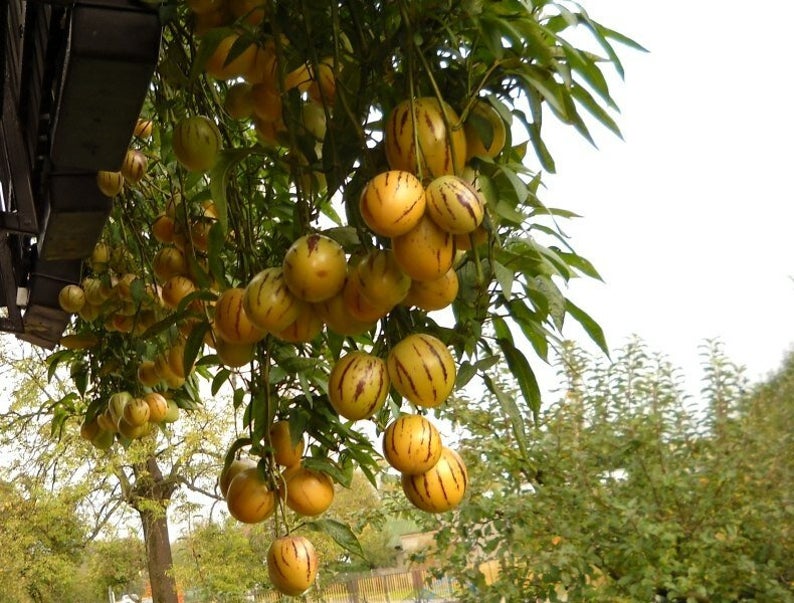
Growing Pepinos in Pots
If you want to grow your pepino plant in a pot, it will need to be in well-draining soil. Otherwise, the roots may not have enough room to breathe and you may be in danger of overwatering it.
Get the best soil you can as this is the growing medium your plant will derive its nutrientm. Make sure the pot is proportionate to the size of the bush and will give enough space for the plant to grow. It should have plenty of drainage holes.
You can slowly introduce the potted plant to direct sunlight by exposing it a little more every day.On thee first day, leave it out for 2 – 3 hours in the morning. Then increase the time by 1 – 2 hours each day. It shouldn’t take more than 10 days to completely expose your pepino bush to direct sunlight.
When the pepino plant is ready to handle sunlight, you can transfer it into a larger pot and place it outside. Alternatively, you can grow it indoors year round.
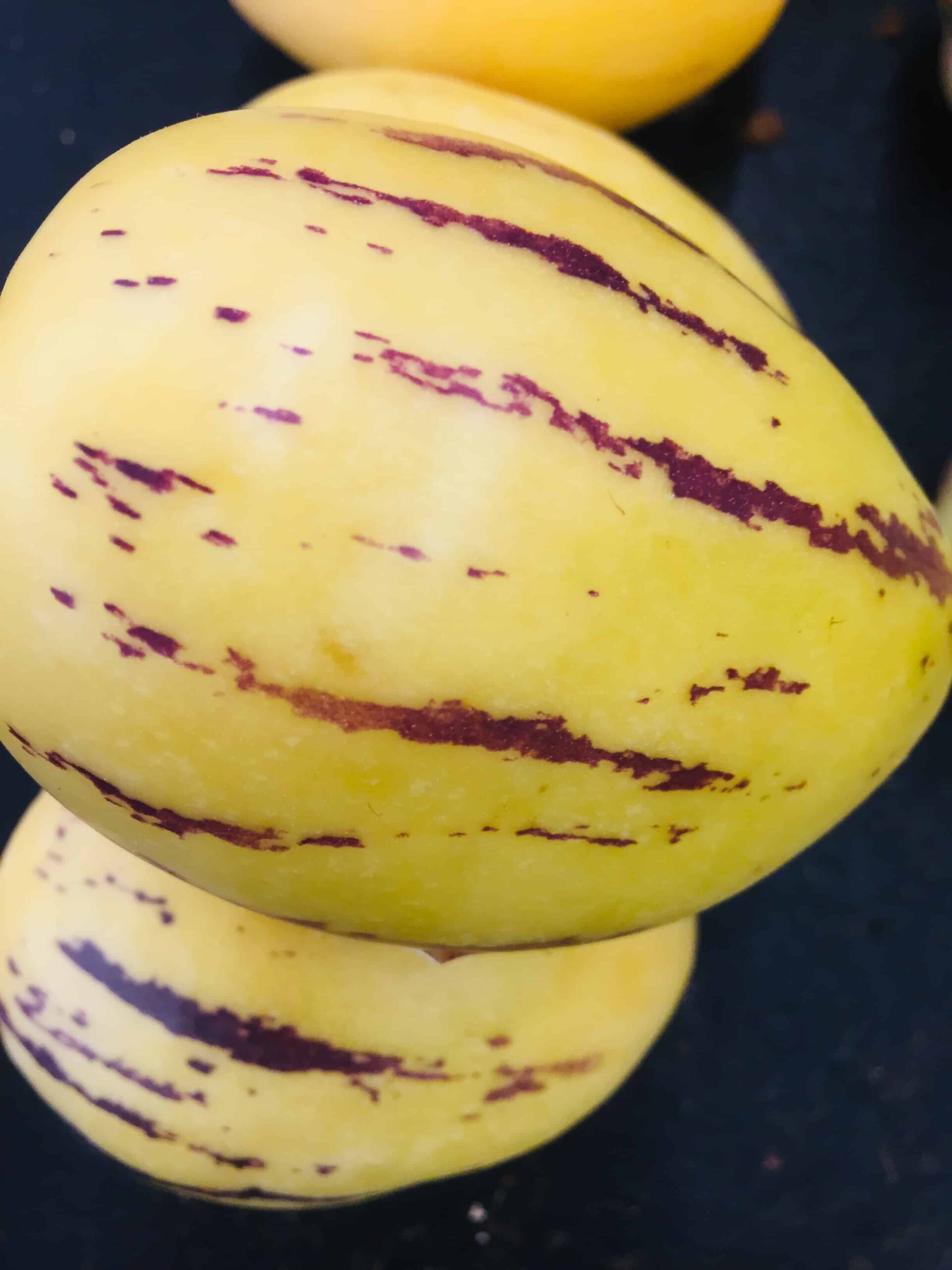
Propagating from Cuttings
You can easily grow new pepino plants from cuttings. Cut a 10cm stem and discard its lower leaves. You can propagate it in either soil or water.
If you grow it in potting soil, make sure you place it in a pot that can drain well. The pots should be in a bright spot but out of direct sunlight. Water it daily, and the roots should form in about a few weeks. You can then plant it in the garden or transfer it to a larger pot.
If you grow the cuttings in water, place them in a glass jar with water and put them in a bright spot without direct sunlight.
Every 3 – 4 days, make sure to change the water. The leaves should not touch the water. In about two weeks, the roots should form and can be potted into well-draining soil.
How Does Pepino Pollinate
Pepino melons are parthenocarpic, meaning it is a self-pollinating plant. You can plant just one if you wish.
How Long Until Fruit
If you live in a warm climate, you can expect pepino fruit to ripen all year. More commonly, pepino bushes flower in the spring then produce fruit through the spring through fall. A newer pepino dulce plant may produce fruit as early as 4 – 6 months after planting, but more often it will take about 12 months for a new plant to fruit.
Once the self-fertilizing white and purple flowers bloom on the bush, it will take between 60 – 80 days for the fruit to grow and become ripe enough to harvest. It will usually set fruit when night temperatures are above 65 degrees Fahrenheit, or 18 degrees Celsius.
Harvesting Pepino
Once the pepino fruit has turned a golden yellow color and purple stripes have formed, it is ready to harvest. The purple stripes may be faint or unseen if the plant was grown under shade. You can also tell when it is ready to harvest because the fruit will be softer and may bruise easily.
To harvest a ripe pepino melon, you just need to pluck it from the bush. It should come off after a few tugs. If you pick them right before they become ripe, you can leave them at room temperature to continue ripening until you are ready to eat them. Otherwise, you can store them in the refrigerator for up to 4 weeks.
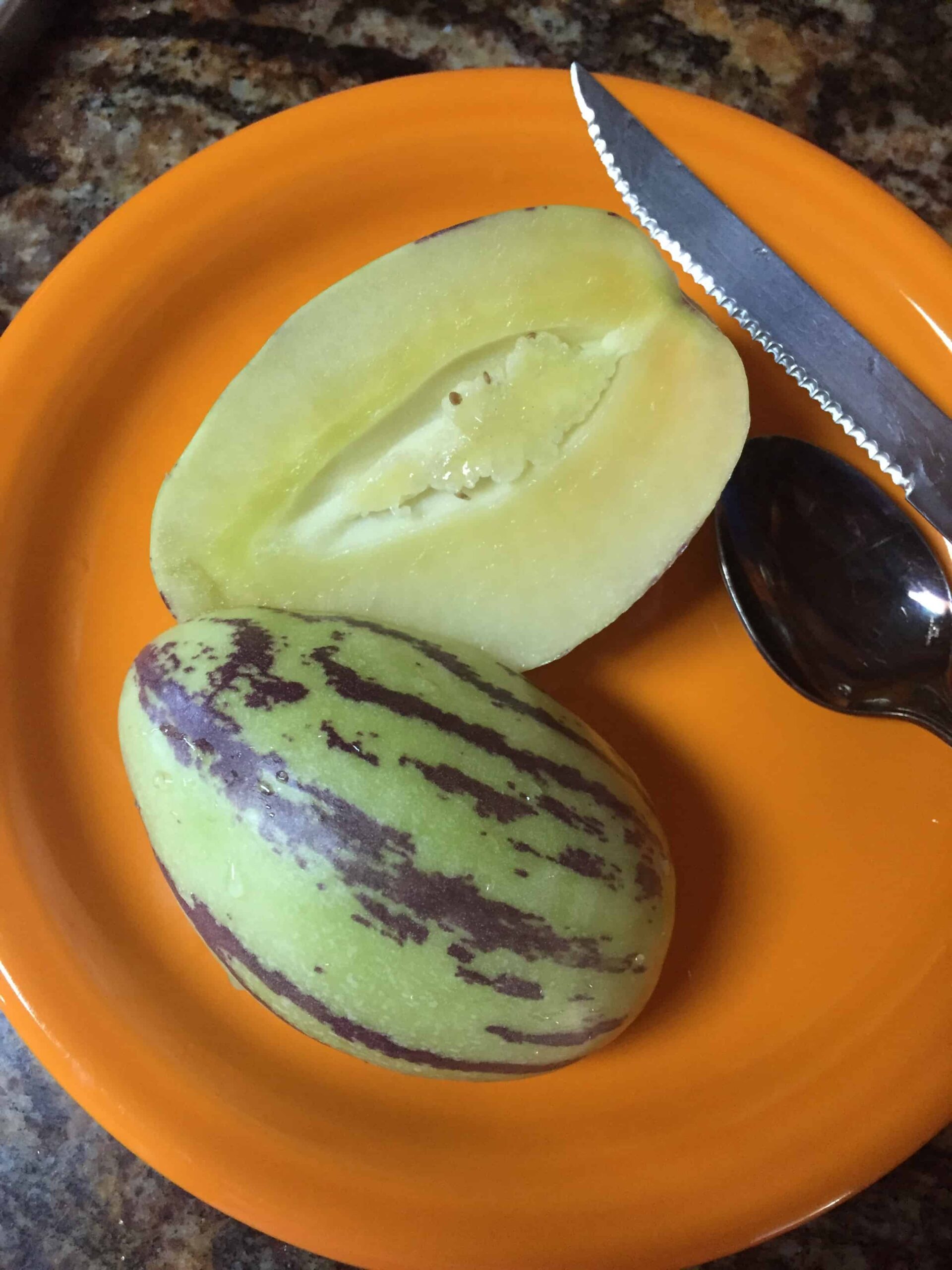
Conclusion
Unlike other melons you may think of, such as growing watermelon, pepinos don’t vine. They grow on shrubs. This makes them ideal to add to a backyard orchard, small garden area, and in containers on decks or patios.
Growing pepino melons is simple because of the shrub’s hardiness. It’s a perennial fruiting shrub that produces fruit year-round, except winters, and gives off a sweet smell.
Appearance-wise, it has some striping and is light green or yellow gold.
Pepino melons are a mild fruit to eat at any time of the year. There are several ways to eat it depending on your taste preference, either by itself or in salads or other meals. It’s easy to bite right into for a refreshing snack. They are filled with antioxidants, vitamin A, B, C, minerals and fiber.
Featured image credit of pepino melons ~ Dawn Head

